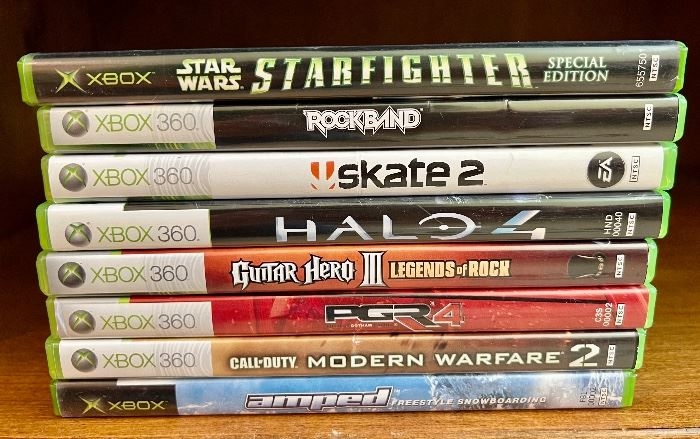Back to the Past: Retro Gaming at Estate Sales

Video games can be vintage. We know – we’re just as shocked as you. It seems like yesterday; we were digging out the suspicious PlayStation-shaped box beneath the Christmas tree. But before you lament the inexorable passage of time, consider this: old consoles and games are very in vogue these days. With a little luck, the retro gaming enthusiast can find spicy deals at estate sales. Or perhaps you’re a collector full up on uranium glass and farmer’s almanacs and looking for something new to love.
The next time you’re cruising a sale in person or on EstateSales.NET, keep an eye out for these sweet old-school gaming items to complement your collection.
Retro Gaming Consoles – From Atari to Xbox

Games are great, but they’re better when you can actually play them. Enter the gaming console. More than mere receptacles for your compact discs, consoles are portals to myriad and varied realms you can explore from the comfort of your living room couch. If you want to use the games you find, you’ll need to start your collection with a console.
Some consoles will come bundled with peripherals. What good is a console without audio-visual cables or a controller? So to serve as your retro gaming foundation, you’ll need to check off the following:
- Game console (e.g. GameCube, NES, PlayStation, etc.)
- Power cable
- Audio-video cables (may be proprietary or universal like HDMI depending on console)
- Storage media (some consoles like the PlayStation and GameCube require a memory card to save games; for some, storage is inbuilt)
- Controller (or more than one if you want to engage in multiplayer)
- Games (can be cartridges, compact discs, or fully digital depending on the console)
Remember how we said retro gaming was in vogue? Sales of gaming peripherals and retro games at estate sales have risen like a phoenix in recent years, with some doubling or tripling in value. And backward compatibility between some legacy peripherals and newer generation consoles means that old controllers or storage media may have already found a new home.
Ensuring you have all the bits and bobs for retro gaming is only half the battle. The other half is deciding what to play.
Timeless Code: Retro Games

Not all game disks and cartridges are equivalent. Most are specific to certain consoles – and frankly, we’d love to see someone try to jam a Nintendo 64 cartridge into a GameBoy Advance. But if you’re feeling more playful and less destructive, you’d best ensure you get the right games for the gear.
Here are a few handy tips and tricks you can use at your next estate sale to identify games and pair them with consoles:
- If it comes on a disk, it’s suited for a home computer or modern gaming console like an Xbox, PlayStation, or Nintendo Wii. Check for console specific symbols on the disk, or text indicating PC or Mac. Mini-sized discs likely go with a GameCube.
- If it comes on a small, SD-card shaped cartridge, it either belongs to a handheld like the Nintendo DS, the PS Vita, or the Nintendo Switch.
- If it’s a cartridge shaped like a small matchbox, it likely belongs to the GameBoy or GameBoy Advance.
- If it’s a medium sized cartridge, it’s likely a SNES or Nintendo 64 game. Note that the Nintendo 64 cartridges have rounded sides while the SNES cartridges are more square.
- If it’s a large sharp-angled cartridge with the width and height of a trade paperback, it’s likely a Nintendo Entertainment System (NES) game.
There’s a whole world of games out there in all shapes and sizes. Fortunately, modern consoles and computers tend to use common formats these days. But for treasure hunters seeking retro games at estate sales, it pays to know your discs from your cartridges. Google is your friend here – searching for any console name followed by “game” is sure to produce some helpful visual aids. Beyond that, be ready to do some digging.
Other Pitfalls of Classic Games

Even if you’ve got a working console and a suitable game, you may still encounter some roadblocks. Certain games – especially cartridge-based ones from the mid-90s and early-00s – included watch batteries inside to keep track of time and enable other unique functionality. Once the battery dies, the game may still be playable – but you won’t be able to keep your saves, among other annoyances. A screwdriver and a spare battery, along with a bit of patience and a steady hand, can remedy this situation.
For disk-based games, scratches are a concern. Your computer (or gaming console) uses a laser to load the game’s data off the disk. For the laser reading data, scratches become like clouds on a sunny day. If the laser can’t shine brightly upon your game’s data, you won’t be having any fun in the sun. But scratches aren’t the end of the world, as those in the clear plastic surface on the bottom of a disc can be repaired. CD repair kits can resurface the plastic to like-new condition with a bit of effort. However, be advised that scratches in the top, opaque metallic surface of the disk means lost data – and that data can’t be recovered nor the scratches repaired. You can refurbish old games to work like new with a bit of luck and the right tool for the job. But covering the steps of that process may be an article for another time.
Whether you’re looking to build a legendary collection or conquer some legendary challenges, we wish you all the best in your retro gaming endeavors. Until next time, we’ll be challenging our friends to Mario Kart and complaining about Blue Shells.